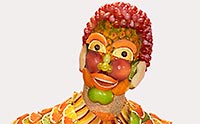The End of the Stop-Motion Doughboy
Since his debut in the mid-1960s, the Pillsbury Doughboy was brought to life through stop-motion animation. However, in 1992, it was decided to change the technique to CGI. It was my pleasure to animate the Doughboy for his final stop-motion commercial campaign at Apogee Inc., for the Leo Burnett advertising agency. A couple of commercials were created simultaneously under the direction of effects legend John Dykstra, and I was chosen to animate one of them, which had a Christmas theme. The budget for the project was clearly high, as they offered me more than my normal pay rate. Of course, they also expected the highest quality animation possible in return. I was given a luxurious amount of time to do tests and experiment with the character's performance, which was far from the norm of a typical stop-motion shoot.
The shooting setup was a seamless white stage on which I animated the Doughboy puppet and a few kitchen props. Replacement heads were used for facial expressions, which was difficult as it required his hat to be removed and carefully re-aligned with every head change. For the iconic finger poke, I used a prop hand and strove for a more exaggerated reaction than what the Doughboy typically does. In post-production, a real hand was composited over the prop hand, and holiday graphic elements were added to spice things up.
Although most commercials are only broadcast for a short time, this one was shown for many years. Pillsbury even repurposed my animation for a Halloween cookie commercial. In the name of progress, the Doughboy has been computer-generated ever since. While CGI may look technically superior, I contend that the traditional stop-motion technique presents a more charming and realistic Doughboy to the audience.

Doughboy commercial © 1992 Pillsbury.







































